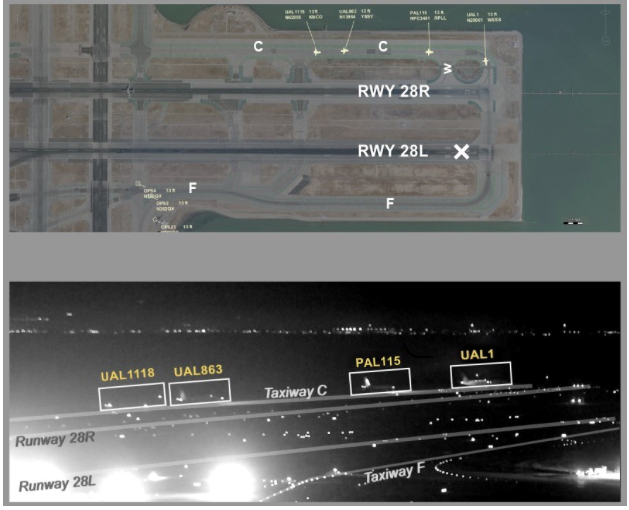Investigation reports » Air Canada - Near Miss at San Francisco Airport
Air Canada - NTSB Report – AC759 near Miss at San Francisco Airport (July 7, 2017)
At about 23:56 LT on July 7, 2017, Air Canada flight 759 (ACA759), an Airbus A320, C-FKCK was cleared to land on runway 28R at San Francisco International Airport (SFO), California. But instead, it lined up on parallel taxiway C, where four air carrier airplanes were awaiting take-off clearance, including Philippine Airlines Airbus A340, United Airlines Boeing 787 and Boeing 737.
ACA759 descended below 100 feet above the ground, and the flight crew advanced the thrust levers to initiate a go-around about the time it overflew the first airplane on the taxiway.
The following facts are provided by the NTSB (National Transportation and Safety Board) as an investigative update:
Airport
- Runway 28L was closed to accommodate construction; its approach and runway lights were turned off, and a 20.5-ft-wide lighted flashing X (runway closure marker) was placed at the threshold. Construction on runway 28L was part of a project that started on February 21, 2017, and notices to airmen were issued to alert operators of its operational status.
- Automatic Terminal Information Service Q was current and included an advisory that runway 28L was closed and that its approach lighting system was out of service.
- Runway and approach lighting for runway 28R were on and set to default settings, which included a 2,400-ft approach lighting system, a precision approach path indicator, touchdown zone lights (white), runway centreline lights (white at the approach end), runway threshold lights (green), and runway edge lights (white at the approach end).
- Lights for taxiway C were also on and set to default settings that included centreline lights (green) along its length. Default settings also included edge lights (blue) and centreline lights (green) illuminating the transition or stub taxiways from the runway to the taxiway.
Pilots
- The captain was the pilot flying ACA759, and the first officer was the pilot monitoring. Both pilots held Canadian airline transport pilot certificates.
- The captain had over 20,000 total flight hours, of which about 4,797 hours were as captain in Airbus A320‑series airplanes. The first officer had about 10,000 total flight hours, of which over 2,300 hours were in Airbus A320-series airplanes.
ATC
- There were no known ATC equipment discrepancies.
- Normal air traffic staffing for the ATC tower midnight shift included two controllers. On the evening of the incident, one controller was in the tower cab.
- At 2349 PDT (7 minutes before the incident), all positions in the ATC tower (controller-in-charge local control, local control assist, ground control, flight data and clearance delivery) were combined at the local control position.
The Incident
- At 2346:30 PDT, Northern California TRACON cleared ACA759 for the FMS bridge visual runway 28R approach.
- FDR data indicate that, during the final 3 nautical miles of the approach, the airplane’s flightpath was lined up with the taxiway and maintained the runway heading.
- At 2355:46 PDT, when ACA759 was about 0.7 mile from the landing threshold and about 300 ft above ground level (agl), the flight crew contacted the ATC tower, mentioned seeing lights on the runway, and requested confirmation that the flight was cleared to land.
- As ACA759 approached SFO at 2355:52 PDT, the airplane flew too far right of course to be observed by the local controller’s ASDE-X/ASSC and was not visible on the ASDE-X/ASSC display for about 12 seconds.
- At 2355:56 PDT, when ACA759 was about 0.3 mile from the landing threshold, the local controller confirmed and re-cleared ACA759 to land on runway 28R.
- The flight crew of the first airplane in queue on taxiway C (UAL1) transmitted statements regarding ACA759, one of which mentioned the alignment of ACA759 with the taxiway while ACA759 was on short final (see figures). The flight crew of the second airplane in queue on taxiway C switched on their airplane’s landing lights as the incident airplane approached.

